2013 Hyundai Sonata Hybrid steering wheel
[x] Cancel search: steering wheelPage 311 of 425
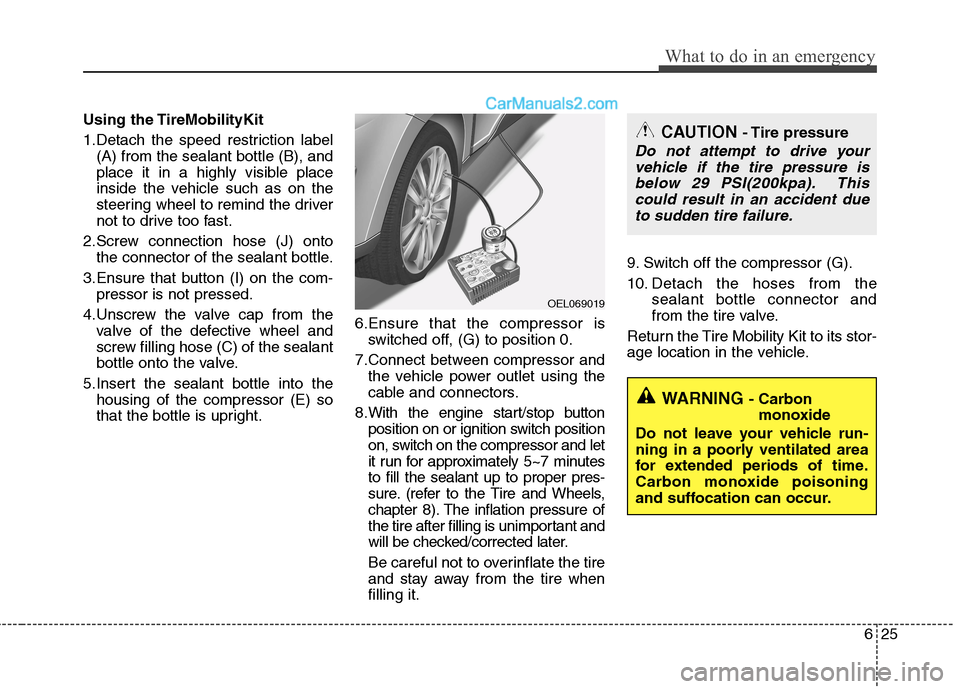
625
What to do in an emergency
Using the TireMobilityKit
1.Detach the speed restriction label
(A) from the sealant bottle (B), and
place it in a highly visible place
inside the vehicle such as on the
steering wheel to remind the driver
not to drive too fast.
2.Screw connection hose (J) onto
the connector of the sealant bottle.
3.Ensure that button (I) on the com-
pressor is not pressed.
4.Unscrew the valve cap from the
valve of the defective wheel and
screw filling hose (C) of the sealant
bottle onto the valve.
5.Insert the sealant bottle into the
housing of the compressor (E) so
that the bottle is upright.6.Ensure that the compressor is
switched off, (G) to position 0.
7.Connect between compressor and
the vehicle power outlet using the
cable and connectors.
8.With the engine start/stop button
position on or ignition switch position
on, switch on the compressor and let
it run for approximately 5~7 minutes
to fill the sealant up to proper pres-
sure. (refer to the Tire and Wheels,
chapter 8). The inflation pressure of
the tire after filling is unimportant and
will be checked/corrected later.
Be careful not to overinflate the tire
and stay away from the tire when
filling it.9. Switch off the compressor (G).
10. Detach the hoses from the
sealant bottle connector and
from the tire valve.
Return the Tire Mobility Kit to its stor-
age location in the vehicle.
OEL069019
CAUTION - Tire pressure
Do not attempt to drive your
vehicle if the tire pressure is
below 29 PSI(200kpa). This
could result in an accident due
to sudden tire failure.
WARNING - Carbon
monoxide
Do not leave your vehicle run-
ning in a poorly ventilated area
for extended periods of time.
Carbon monoxide poisoning
and suffocation can occur.
Page 319 of 425
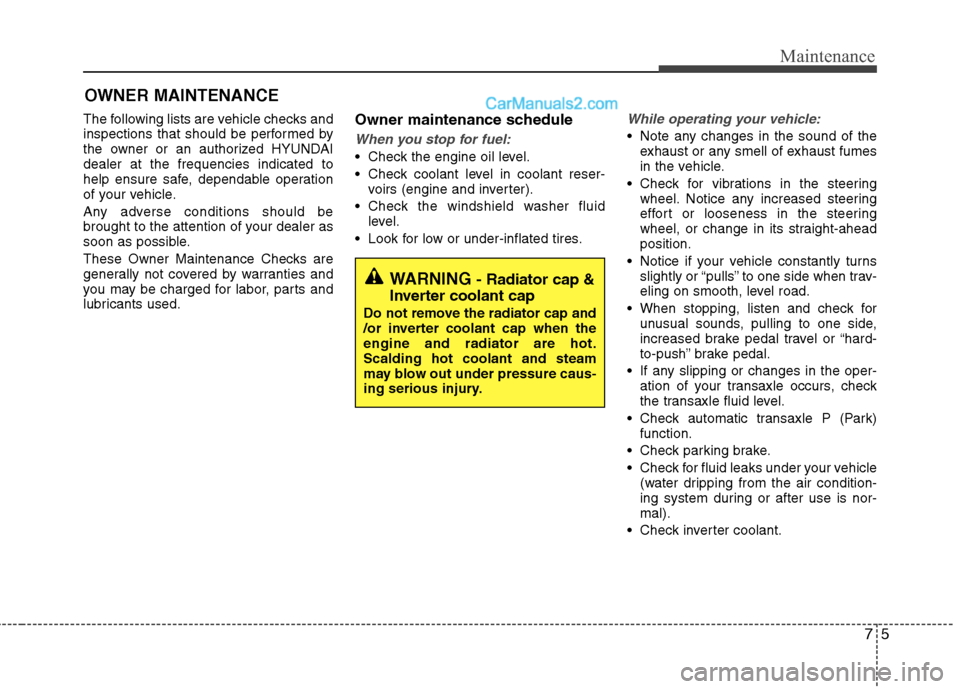
75
Maintenance
OWNER MAINTENANCE
The following lists are vehicle checks and
inspections that should be performed by
the owner or an authorized HYUNDAI
dealer at the frequencies indicated to
help ensure safe, dependable operation
of your vehicle.
Any adverse conditions should be
brought to the attention of your dealer as
soon as possible.
These Owner Maintenance Checks are
generally not covered by warranties and
you may be charged for labor, parts and
lubricants used.Owner maintenance schedule
When you stop for fuel:
Check the engine oil level.
Check coolant level in coolant reser-
voirs (engine and inverter).
Check the windshield washer fluid
level.
Look for low or under-inflated tires.
While operating your vehicle:
Note any changes in the sound of the
exhaust or any smell of exhaust fumes
in the vehicle.
Check for vibrations in the steering
wheel. Notice any increased steering
effort or looseness in the steering
wheel, or change in its straight-ahead
position.
Notice if your vehicle constantly turns
slightly or “pulls” to one side when trav-
eling on smooth, level road.
When stopping, listen and check for
unusual sounds, pulling to one side,
increased brake pedal travel or “hard-
to-push” brake pedal.
If any slipping or changes in the oper-
ation of your transaxle occurs, check
the transaxle fluid level.
Check automatic transaxle P (Park)
function.
Check parking brake.
Check for fluid leaks under your vehicle
(water dripping from the air condition-
ing system during or after use is nor-
mal).
Check inverter coolant.
WARNING - Radiator cap &
Inverter coolant cap
Do not remove the radiator cap and
/or inverter coolant cap when the
engine and radiator are hot.
Scalding hot coolant and steam
may blow out under pressure caus-
ing serious injury.
Page 335 of 425
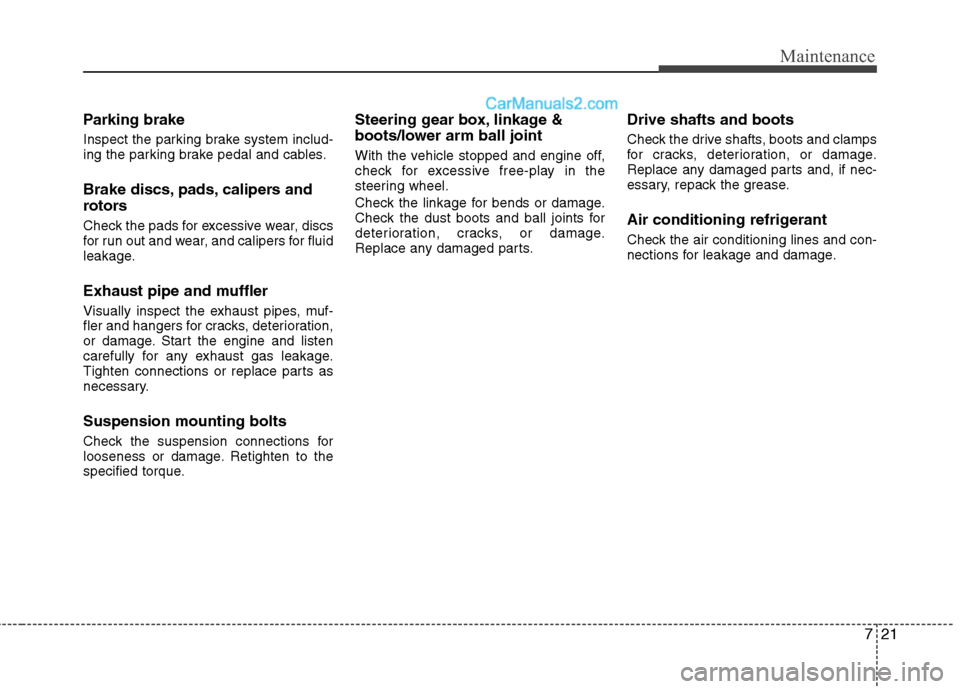
721
Maintenance
Parking brake
Inspect the parking brake system includ-
ing the parking brake pedal and cables.
Brake discs, pads, calipers and
rotors
Check the pads for excessive wear, discs
for run out and wear, and calipers for fluid
leakage.
Exhaust pipe and muffler
Visually inspect the exhaust pipes, muf-
fler and hangers for cracks, deterioration,
or damage. Start the engine and listen
carefully for any exhaust gas leakage.
Tighten connections or replace parts as
necessary.
Suspension mounting bolts
Check the suspension connections for
looseness or damage. Retighten to the
specified torque.
Steering gear box, linkage &
boots/lower arm ball joint
With the vehicle stopped and engine off,
check for excessive free-play in the
steering wheel.
Check the linkage for bends or damage.
Check the dust boots and ball joints for
deterioration, cracks, or damage.
Replace any damaged parts.
Drive shafts and boots
Check the drive shafts, boots and clamps
for cracks, deterioration, or damage.
Replace any damaged parts and, if nec-
essary, repack the grease.
Air conditioning refrigerant
Check the air conditioning lines and con-
nections for leakage and damage.
Page 355 of 425
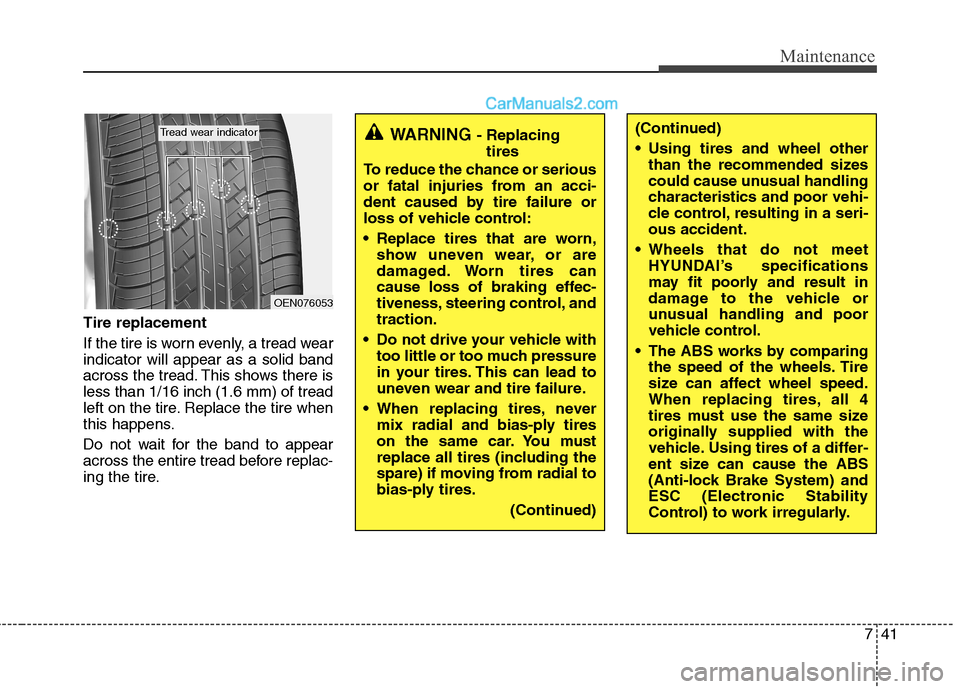
741
Maintenance
Tire replacement
If the tire is worn evenly, a tread wear
indicator will appear as a solid band
across the tread. This shows there is
less than 1/16 inch (1.6 mm) of tread
left on the tire. Replace the tire when
this happens.
Do not wait for the band to appear
across the entire tread before replac-
ing the tire.
OEN076053
Tread wear indicatorWARNING - Replacing
tires
To reduce the chance or serious
or fatal injuries from an acci-
dent caused by tire failure or
loss of vehicle control:
Replace tires that are worn,
show uneven wear, or are
damaged. Worn tires can
cause loss of braking effec-
tiveness, steering control, and
traction.
Do not drive your vehicle with
too little or too much pressure
in your tires. This can lead to
uneven wear and tire failure.
When replacing tires, never
mix radial and bias-ply tires
on the same car. You must
replace all tires (including the
spare) if moving from radial to
bias-ply tires.
(Continued)(Continued)
Using tires and wheel other
than the recommended sizes
could cause unusual handling
characteristics and poor vehi-
cle control, resulting in a seri-
ous accident.
Wheels that do not meet
HYUNDAI’s specifications
may fit poorly and result in
damage to the vehicle or
unusual handling and poor
vehicle control.
The ABS works by comparing
the speed of the wheels. Tire
size can affect wheel speed.
When replacing tires, all 4
tires must use the same size
originally supplied with the
vehicle. Using tires of a differ-
ent size can cause the ABS
(Anti-lock Brake System) and
ESC (Electronic Stability
Control) to work irregularly.
Page 387 of 425
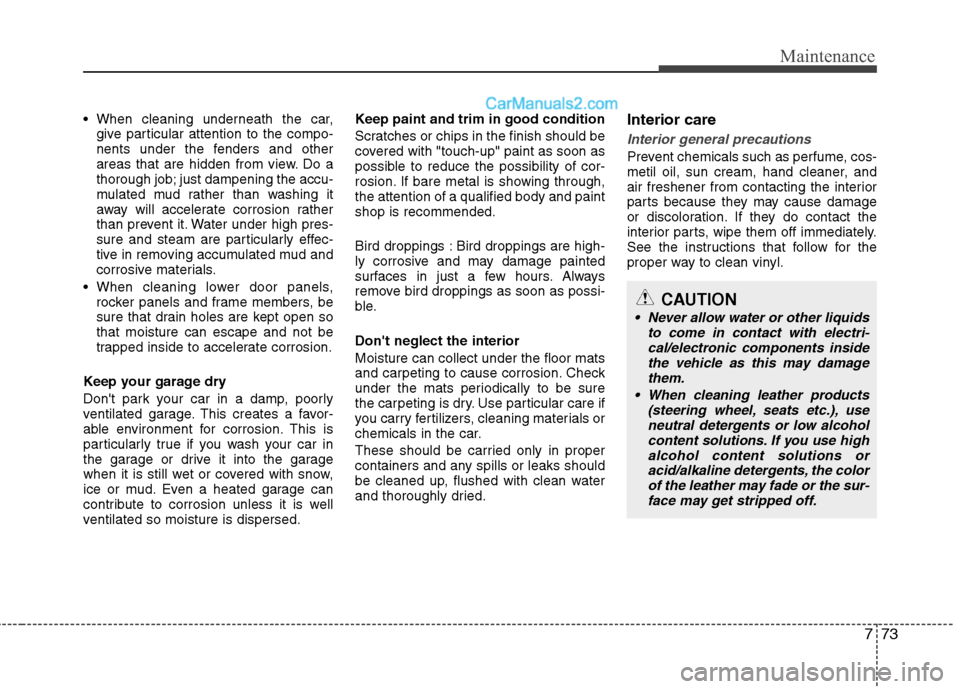
773
Maintenance
give particular attention to the compo-
nents under the fenders and other
areas that are hidden from view. Do a
thorough job; just dampening the accu-
mulated mud rather than washing it
away will accelerate corrosion rather
than prevent it. Water under high pres-
sure and steam are particularly effec-
tive in removing accumulated mud and
corrosive materials.
rocker panels and frame members, be
sure that drain holes are kept open so
that moisture can escape and not be
trapped inside to accelerate corrosion.
Keep your garage dry
Don't park your car in a damp, poorly
ventilated garage. This creates a favor-
able environment for corrosion. This is
particularly true if you wash your car in
the garage or drive it into the garage
when it is still wet or covered with snow,
ice or mud. Even a heated garage can
contribute to corrosion unless it is well
ventilated so moisture is dispersed.Keep paint and trim in good condition
Scratches or chips in the finish should be
covered with "touch-up" paint as soon as
possible to reduce the possibility of cor-
rosion. If bare metal is showing through,
the attention of a qualified body and paint
shop is recommended.
Bird droppings : Bird droppings are high-
ly corrosive and may damage painted
surfaces in just a few hours. Always
remove bird droppings as soon as possi-
ble.
Don't neglect the interior
Moisture can collect under the floor mats
and carpeting to cause corrosion. Check
under the mats periodically to be sure
the carpeting is dry. Use particular care if
you carry fertilizers, cleaning materials or
chemicals in the car.
These should be carried only in proper
containers and any spills or leaks should
be cleaned up, flushed with clean water
and thoroughly dried.Interior care
Interior general precautions
Prevent chemicals such as perfume, cos-
metil oil, sun cream, hand cleaner, and
air freshener from contacting the interior
parts because they may cause damage
or discoloration. If they do contact the
interior parts, wipe them off immediately.
See the instructions that follow for the
proper way to clean vinyl.
CAUTION
Never allow water or other liquids
to come in contact with electri-
cal/electronic components inside
the vehicle as this may damage
them.
When cleaning leather products
(steering wheel, seats etc.), use
neutral detergents or low alcohol
content solutions. If you use high
alcohol content solutions or
acid/alkaline detergents, the color
of the leather may fade or the sur-
face may get stripped off.
Page 418 of 425
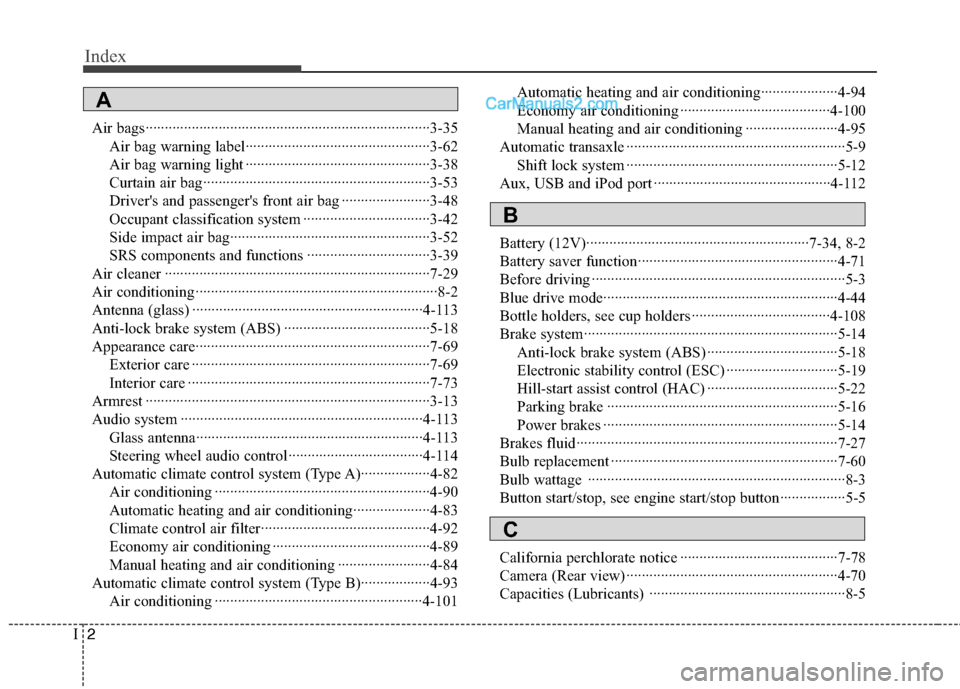
Index
2I
Air bags··········································································3-35
Air bag warning label················································3-62
Air bag warning light ················································3-38
Curtain air bag···························································3-53
Driver's and passenger's front air bag ·······················3-48
Occupant classification system ·································3-42
Side impact air bag····················································3-52
SRS components and functions ································3-39
Air cleaner ·····································································7-29
Air conditioning ·······························································8-2
Antenna (glass) ····························································4-113
Anti-lock brake system (ABS) ······································5-18
Appearance care·····························································7-69
Exterior care ······························································7-69
Interior care ·······························································7-73
Armrest ··········································································3-13
Audio system ·······························································4-113
Glass antenna···························································4-113
Steering wheel audio control···································4-114
Automatic climate control system (Type A)··················4-82
Air conditioning ························································4-90
Automatic heating and air conditioning····················4-83
Climate control air filter············································4-92
Economy air conditioning ·········································4-89
Manual heating and air conditioning ························4-84
Automatic climate control system (Type B)··················4-93
Air conditioning ······················································4-101Automatic heating and air conditioning····················4-94
Economy air conditioning ·······································4-100
Manual heating and air conditioning ························4-95
Automatic transaxle ·························································5-9
Shift lock system ·······················································5-12
Aux, USB and iPod port ··············································4-112
Battery (12V)··························································7-34, 8-2
Battery saver function····················································4-71
Before driving ··································································5-3
Blue drive mode·····························································4-44
Bottle holders, see cup holders ····································4-108
Brake system··································································5-14
Anti-lock brake system (ABS) ··································5-18
Electronic stability control (ESC) ·····························5-19
Hill-start assist control (HAC) ··································5-22
Parking brake ····························································5-16
Power brakes ·····························································5-14
Brakes fluid····································································7-27
Bulb replacement ···························································7-60
Bulb wattage ···································································8-3
Button start/stop, see engine start/stop button·················5-5
California perchlorate notice ·········································7-78
Camera (Rear view) ·······················································4-70
Capacities (Lubricants) ···················································8-5
A
B
C
Page 424 of 425
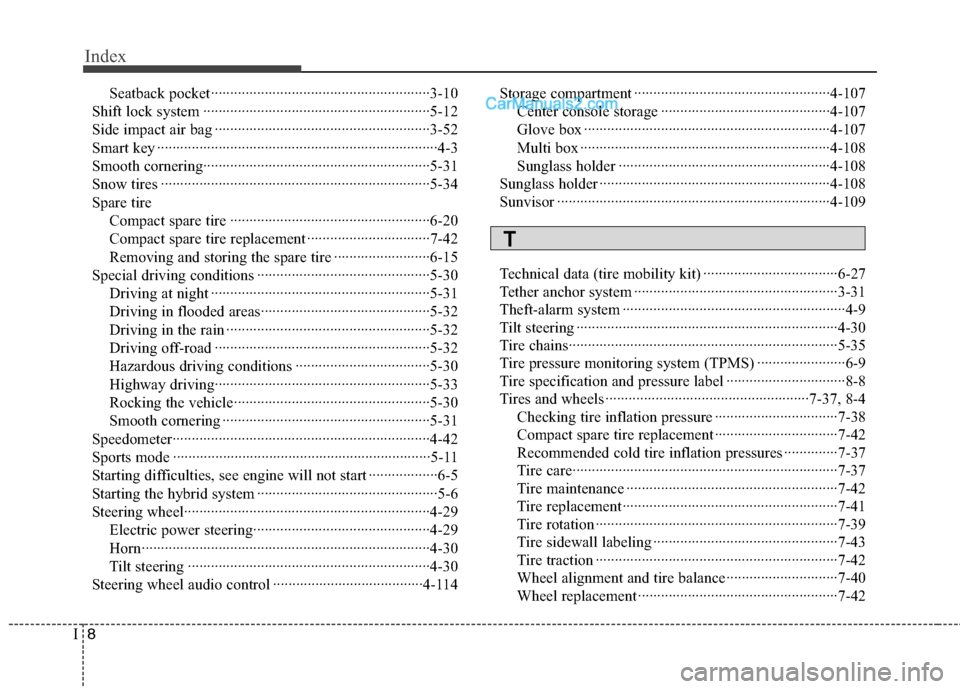
Index
8I
Seatback pocket·························································3-10
Shift lock system ···························································5-12
Side impact air bag ························································3-52
Smart key ·········································································4-3
Smooth cornering···························································5-31
Snow tires ······································································5-34
Spare tire
Compact spare tire ····················································6-20
Compact spare tire replacement ································7-42
Removing and storing the spare tire ·························6-15
Special driving conditions ·············································5-30
Driving at night ·························································5-31
Driving in flooded areas············································5-32
Driving in the rain ·····················································5-32
Driving off-road ························································5-32
Hazardous driving conditions ···································5-30
Highway driving························································5-33
Rocking the vehicle···················································5-30
Smooth cornering ······················································5-31
Speedometer···································································4-42
Sports mode ···································································5-11
Starting difficulties, see engine will not start ··················6-5
Starting the hybrid system ···············································5-6
Steering wheel································································4-29
Electric power steering··············································4-29
Horn···········································································4-30
Tilt steering ·······························································4-30
Steering wheel audio control ·······································4-114Storage compartment ···················································4-107
Center console storage ············································4-107
Glove box ································································4-107
Multi box ·································································4-108
Sunglass holder ·······················································4-108
Sunglass holder ····························································4-108
Sunvisor ·······································································4-109
Technical data (tire mobility kit) ···································6-27
Tether anchor system ·····················································3-31
Theft-alarm system ··························································4-9
Tilt steering ····································································4-30
Tire chains······································································5-35
Tire pressure monitoring system (TPMS) ·······················6-9
Tire specification and pressure label ·······························8-8
Tires and wheels ·····················································7-37, 8-4
Checking tire inflation pressure ································7-38
Compact spare tire replacement ································7-42
Recommended cold tire inflation pressures ··············7-37
Tire care·····································································7-37
Tire maintenance ·······················································7-42
Tire replacement ························································7-41
Tire rotation ·······························································7-39
Tire sidewall labeling ················································7-43
Tire traction ·······························································7-42
Wheel alignment and tire balance ·····························7-40
Wheel replacement ····················································7-42
T